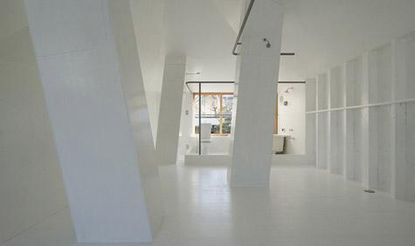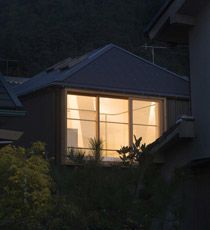Interactive floorplan: Light Well House, Kyoto

This exquisite private house in Kyoto brings together two key concerns of the contemporary Japanese architect: space and light.
Unlike earlier residential projects by Keiichi Hayashi, like the UK house and House for a Couple, the proposed site for the Light Well House was small and hemmed in. This left little space for the long, linear floorplan that characterized his earlier residential projects.
Mindful that both light and space were at a serious premium, 41-year-old architect Keiichi Hayashi has instead placed functions in a vertical stack, drawing light straight through each storey via a series of tubes. A development of the 2005 House on the Mountainside in Hyogo - another stacked structure - the brown metal Light Well House is insular and withdrawn from its surroundings, while creating a generous inner world.

See more images of Lightwell House
The clients – a young couple and their child – had to accept certain preconditions, such as the volume of the house – automatically defined by local building laws. The architect ensured the house was at the centre of the site in order to create two open spaces to the east, where there is a small courtyard, and the west, the entrance elevation facing onto the narrow lane. Each floor is treated as an open plan space, with the light tubes acting as dividers to help shape the floorplan and influence the placing of furniture and activities.
The ground floor contains a living and dining room space, with bedroom and bathroom on the floor above, next to an 'inner terrace', a place for drying clothes and plants.
Hayashi has thought of everything. Not only do the light tubes act as funnels for daylight, they also double up as the structural supports for the house, a set of angular braces that give the upper storey a crazed, expressionist atmosphere. From the ground floor, each 'randomly placed' light well provides a tantalizing glimpse of blue sky.
Wallpaper* Newsletter
Receive our daily digest of inspiration, escapism and design stories from around the world direct to your inbox
The combination of open space and random enclosure demonstrates Hayashi's particular approach. 'To understand the space of the house, I thought of a space in a forest and a space in a grassland,' says Hayashi, 'there are many trees in a forest, and when people are there, these trees will become clues or reference points to create activities.' Rather than the unbounded space of the grassland, the Light Well House has its own set of rules.
'Although the light wells might be thought of as obstacles, I think of them like trees in a forest, creating unexpectedly flexible and free space,' Hayashi muses, adding that 'I wish that this will give the residents the joy of life.' Noble sentiments for a modest house.
Ellie Stathaki is the Architecture & Environment Director at Wallpaper*. She trained as an architect at the Aristotle University of Thessaloniki in Greece and studied architectural history at the Bartlett in London. Now an established journalist, she has been a member of the Wallpaper* team since 2006, visiting buildings across the globe and interviewing leading architects such as Tadao Ando and Rem Koolhaas. Ellie has also taken part in judging panels, moderated events, curated shows and contributed in books, such as The Contemporary House (Thames & Hudson, 2018), Glenn Sestig Architecture Diary (2020) and House London (2022).
-
 LEVC’s L380 is a truly magnificent minivan
LEVC’s L380 is a truly magnificent minivanThe London Electric Vehicle Company’s L380, is a magnificent minivan designed for upscale long-distance travel, as the maker of the London Taxi branches out into all-purpose EVs
By Jonathan Bell Published
-
 Enjoy ocean and jungle bliss at Bespoke Tulum’s residences in Mexico
Enjoy ocean and jungle bliss at Bespoke Tulum’s residences in MexicoBespoke Tulum is an exclusive hospitality complex designed by Muro Rojo Arquitectura on Mexico’s Caribbean coastline
By Sofia de la Cruz Published
-
 In Van Cleef & Arpels’ high jewellery, the archival meets the au courant
In Van Cleef & Arpels’ high jewellery, the archival meets the au courantVan Cleef & Arpels pays tribute to its rich heritage with a captivating high jewellery collection
By Hannah Silver Published